Is Gravetye Manor the perfect English garden?
Is it possible to have a perfect ‘English garden?’ After all, wildness and imperfection is at the heart of the English garden concept.
Gardens are like children. They’re each special in their own way, so it’s impossible to love one more than another.
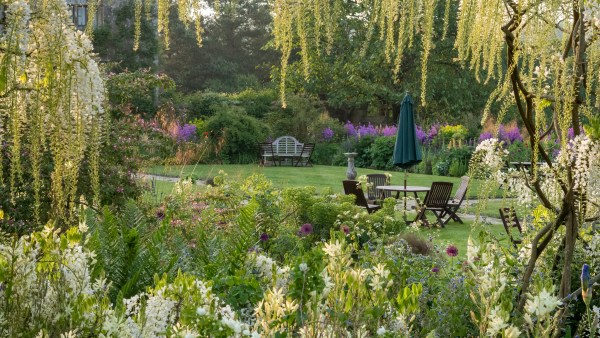
If that’s not a perfect ‘English garden’, then tell me what is.
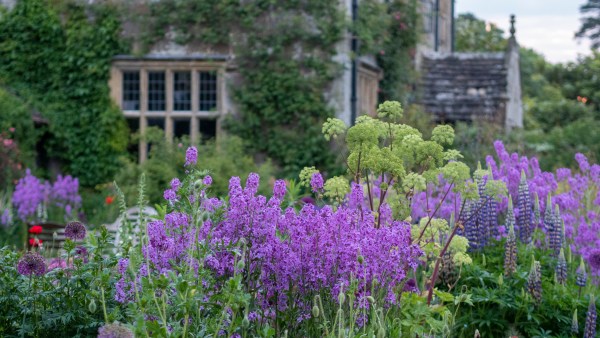
But the garden of Gravetye Manor Hotel is really special. For me, at any rate. We visited it thirty years ago on our honeymoon. I knew nothing about gardening and it was December.
Even so, it was the first ‘proper garden’ that made me think. Its structure, mainly laid out over a hundred years ago by William Robinson, clearly fitted together beautifully. I resolved to return in the height of summer to see what it was like with flowers.
However, Gravetye Manor Hotel is not cheap. Dinner, bed and breakfast is roughly the cost of our lowest-season economy return flight to Australia.
So we had to wait thirty years. But, it was worth it, especially to be in the gardens as the sun rose. That was 4.55 am, by the way.
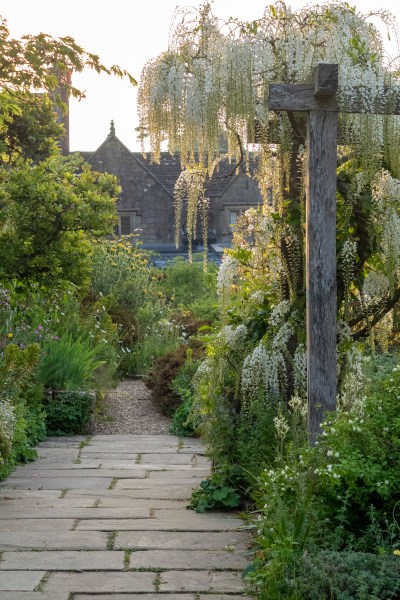
The white wisteria draped over the pergola was stunning, especially in the early morning sunlight.
How the garden was made…
William Robinson has been variously described as the ‘grandfather of the modern English garden’ and the ‘Irishman who taught the English how to garden.’ He created gardens for the wealthy and influential from the mid-nineteenth century onwards.
His best-selling garden books, some of which can still be found, were first published in the 1870s. He bought Gravetye Manor and its 1,000 acres in 1885, with the proceeds of his success. When he died, he left it to the Forestry Commission who have leased it out as a hotel since 1958.
In 2010, the hotel was almost in administration, but it was bought by Jeremy and Elizabeth Hosking. Having known and loved it for years, they set about restoring it sympathetically, engaging Tom Coward as head gardener.
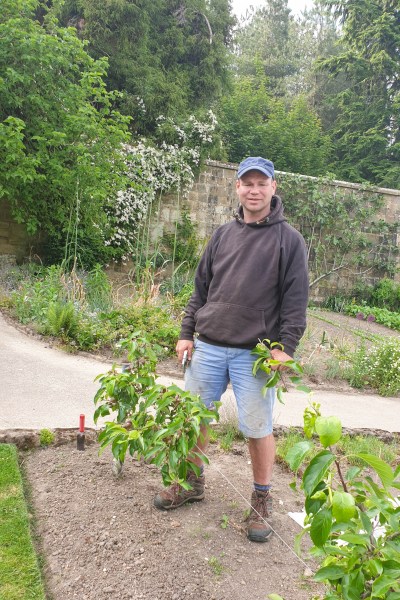
Gravetye Manor head gardener Tom Coward
‘My job is to renovate rather than to restore,’ he says. ‘We wanted a garden that Robinson would have approved of. There’s a saying “tradition is not to copy the achievements of great people, but to continue seeking what they sought”‘.
Tom is replanting trees and shrubs that Robinson loved, so that they will be there for the future. But he’s also using plants that Robinson would never have known.
The layout of an English garden…
William Robinson’s legacy to English garden style includes the concepts of the mixed flower border and the wild garden.
The layout of Gravetye is superb. A formal garden edged with mixed borders opens out from the house. To one side the hill slopes away into a meadow garden which goes down to a small lake. Then the countryside rises up beyond.
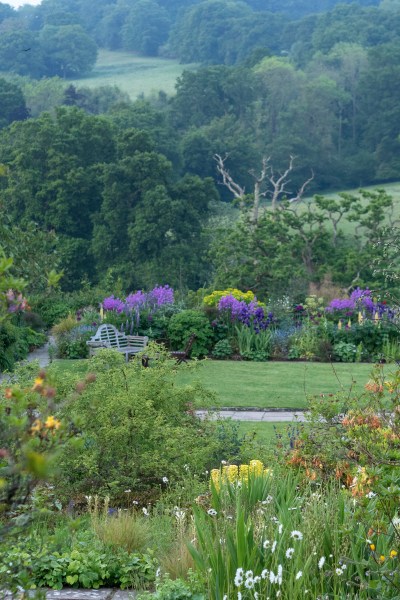
The formal lawn edged with mixed borders lies just outside the doors of the house. Between it and the countryside view lies a wildflower meadow and a small lake. All ‘English garden’ elements!
On the other side of the house, the garden rises uphill, with a mix of formal and informal planting.
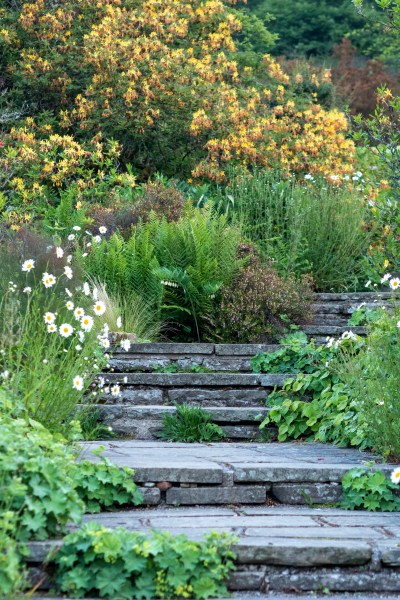
The most beautiful garden steps? I think so.
There are steps up through semi-wild woodland, up to the gates of one of the last great house vegetable gardens still working in Britain.
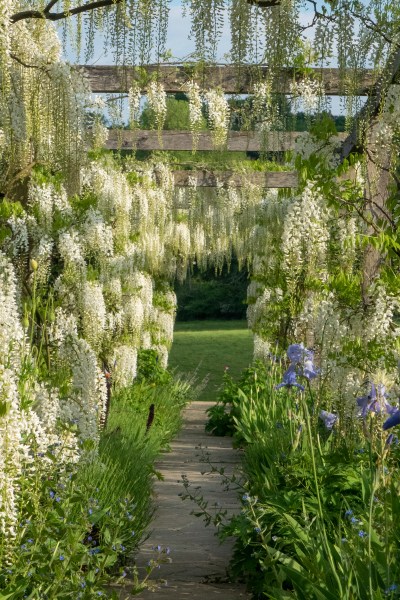
This pergola draped in white wisteria borders the formal part of the garden. On the other side is informal and meadow planting.
Robinson liked the cultivated and the wild to sit side by side. This is at the heart of the ‘English garden’ concept.
In his book The English Flower Garden, he advocates marking out the boundary between the formal and the informal with an arch or pergola. He suggests planting this with beautiful vines.
At Gravetye Manor there is just such a pergola, on the boundary between the formal garden and the orchard. Currently, there is a stunning white wisteria wound round it. Beyond that lies the orchard, the wildflower meadow and the beehives.
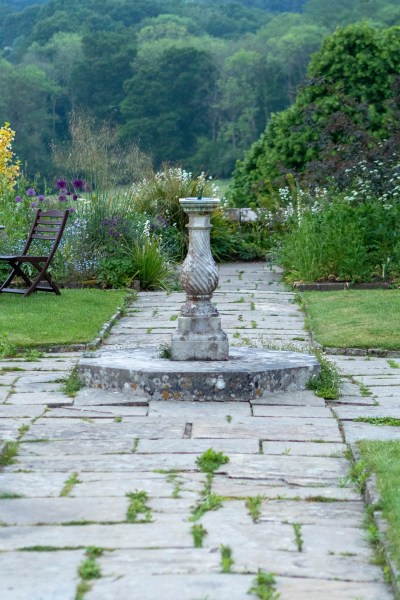
The sundial at the heart of the formal garden. But there is a still an ‘English’ wildness in between the pavers.
The Wild Garden element
The Wild Garden was another successful William Robinson book. (note: links to Amazon are affiliate, see disclosure). By ‘wild’ he didn’t mean a wilderness. He meant that you should grow plants where they would naturally do well.
He also liked to use elements of the wild in his gardens. For example, there were buttercups in the meadow garden when I visited Gravetye. And in the borders was the wild buttercup’s close relation, Ranunculus acris stevenni.
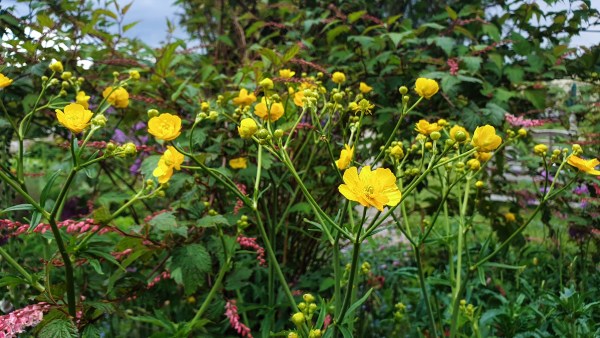
Ranunculus acris stevenni is a taller, more imposing relation of our native wild buttercup. Here seen in one of the borders at Gravetye Manor. Its wild cousin is just a few feet away in the meadow below.
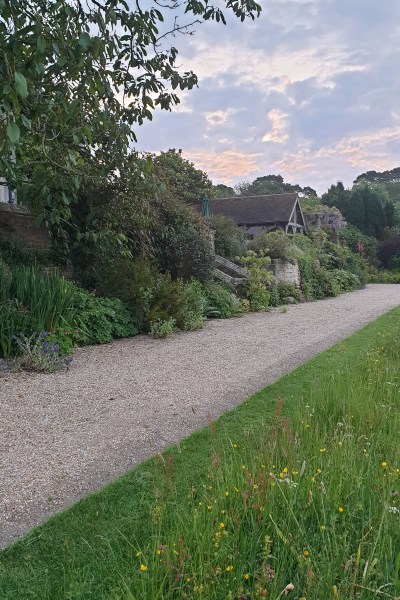
Robinson liked to plant mixed borders against walls. Here the mixed border overlooks a wildflower meadow which drops down to a lake.
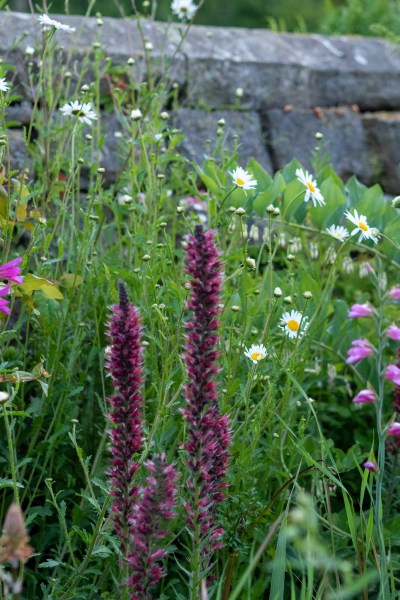
The burgundy spires of Echium russicum (along with the Ranunculus acris stevenii and other plants) were used in The Resilience Garden this year at the RHS Chelsea Flower Show. The Forestry Commission and Gravetye Manor Hotel were sponsors of the show garden designed by Sarah Eberle. It won a well-deserved Gold Medal.
Robinson ‘invented’ the meadow lawn…
William Robinson pioneered the meadow lawn, another English garden concept. We must have lost the idea for nearly 100 years, but it’s now back. (Here’s a post on how to grow a mini meadow in your own garden).
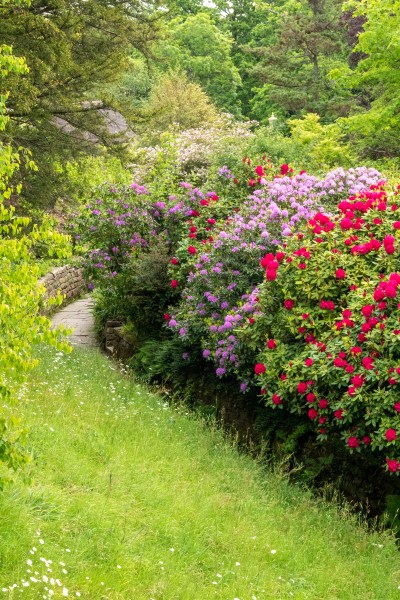
The view from our bedroom. A bank of rhododendrons in full bloom, flanked by a path and a wildflower lawn. William Robinson didn’t restrict himself to native plants. He imported many plants from around the world, such as rhododendrons from South East Asia.
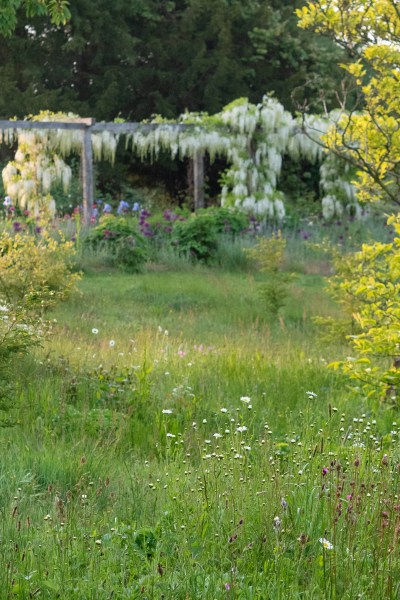
The wisteria arches mark the boundary between the formal garden (on the other side) and the meadow planting (on this side) of the arches.
Robinson on how to create an English garden border
In William Robinson’s time it was fashionable to fill borders with great blocks of colour from exotic annuals. The Victorians travelled the world and loved to bring back plants. But once the colourful display was over, the annuals were yanked out and replaced with something else. Then borders were left bare in winter.
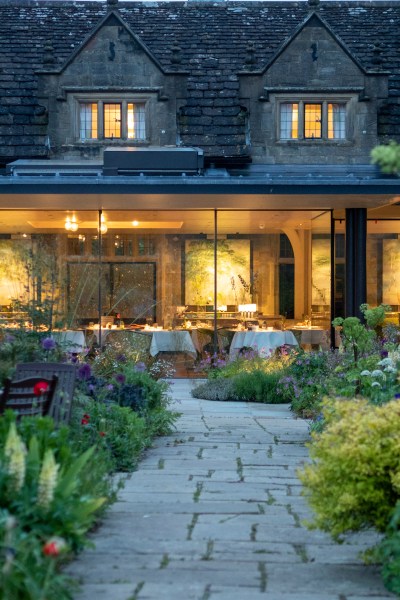
A stone path, flanked by two mixed ‘English garden’ borders, leads to the new restaurant extension at Gravetye Manor Hotel. Its walls are glass, so you feel as if you were sitting in the garden.
William Robinson said that this approach was wasteful and unimaginative. He pioneered the ‘English garden’ idea of a border of mixed perennials, annuals and shrubs, with several seasons of interest.
His trenchant views warned people against falling into popular traps. ‘Don’t repeat favourite plants along the border, as often happens,’ he writes, sternly.
And he didn’t approve of structuring borders with the highest plants at the back and the lowest at the front. He advised having a few taller stand-out plants at the front of borders, and also to have dwarf plants weaving through the bed. And no bare soil!
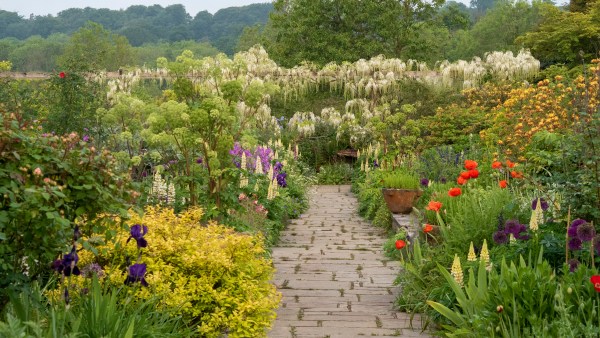
A few splashes of red poppies wake up this otherwise serene mixed border.
Tom Coward has this spirit in his attitude to colour. ‘I like a splash of a clashing colour occasionally in the border,’ he says, pointing to a clump of bright orange poppies that have just come out in apparent opposition to the tasteful blues, whites, yellows and purples all around them. ‘But if there are too many poppies all out at once, I won’t like it.’
There is more advice on how to plant a border like a pro here.
The Gravetye vegetable garden
The Gravetye Manor vegetable garden is probably one of the last walled vegetable gardens still ‘working’ in Britain.
Every estate had a walled vegetable garden. It fed the community around it. However the gardeners were lost in two World Wars. Those that returned didn’t want to work in private gardens and commercial production of fruit and vegetables took over. Now most walled vegetable gardens are built over or have been demolished.
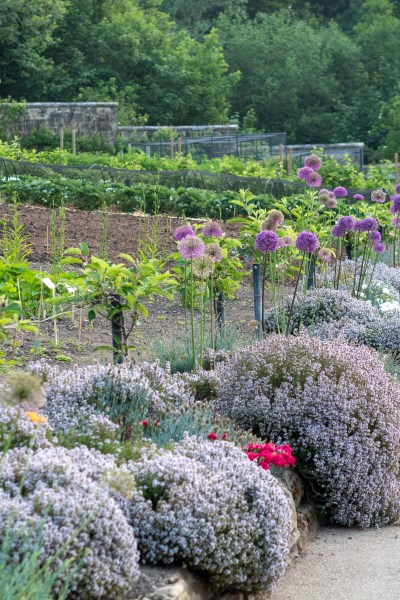
The Gravetye kitchen garden is an unusual oval shape. William Robinson said that he didn’t like awkward corners and the oval gives every wall more opportunity for sunlight.
Tom works closely with the chefs to grow unusual vegetables for the restaurant. They prioritise varieties that are difficult to buy or plants that taste significantly better when grown at home.
He particularly likes to grow fruit. ‘It’s difficult to get perfectly ripe fruit commercially,’ he explains. ‘Fruit has to be transported and stored, so it has to be picked just before it’s ripe. Here we can pick our fruit when it’s absolutely ripe, and that makes a big difference to flavour.’
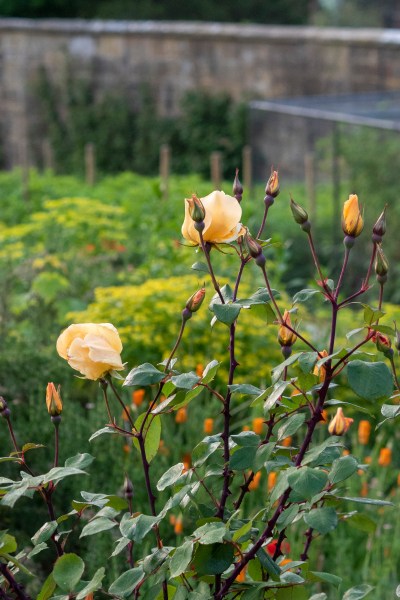
Flowers for the hotel are grown in the kitchen garden.
Tom also grows herbs and unusual vegetables, such as sea kale, and baby vegetables. ‘We plant leeks up in batches, growing several seeds in each module. Then we plant them out in groups and harvest them as baby leeks.’
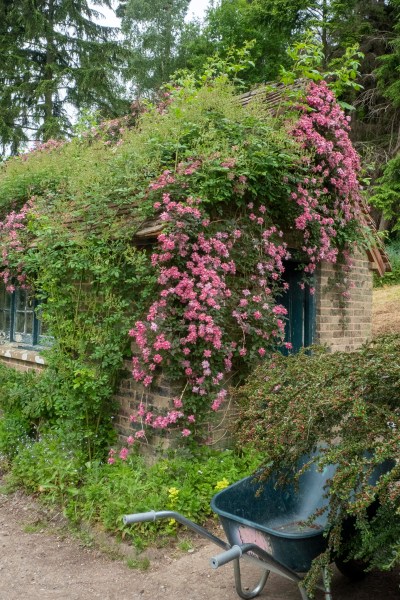
This is the most charming garden shed I’ve seen in a long time. It’s just outside the veg garden and is covered in Clematis ‘Broughton Star.’
See more of this garden in video
I really do think you can get a much better feel of a garden in video, so please let me tempt you to a stroll around the Gravetye Manor Garden here. There are lots more pictures of this gorgeous garden, and you can enjoy the birdsong:
More about William Robinson and Gravetye Manor Hotel
You can book a garden tour with a member of the gardening team even if you’re not staying at the hotel, although places are limited. There are also various events in the garden, but they sell out quickly.
Many of William Robinson’s books are out of print, but I found copies of The Wild Garden. I also discovered an antiquarian copy of it, subtitled ‘Our Groves and Shrubberies Made Beautiful by the Naturalisation of Hardy Exotic Plants. I’m still trying to get my head around what that could possibly mean….
Fellow blogger Jack Wallington visited two days before we did, to celebrate 13 years with his partner. So you can read his view of the gardens, too. Luckily he agrees with me (I think).
And it’s time for us to start saving up for our next visit! I fancy seeing it in winter, because a great English garden in winter is often romantic, melancholy and haunting.
Pin to remember the garden for later

























Thanks for sharing this great article.
I was thinking of purchasing a William Robinson book from amazon to help me with writing about English gardens for my blog.
What book is your favourite and why? Any suggestions would be much appreciated.
All the best and keep up the good work :)
Thank you. Personally I think that Christopher Lloyd’s books are great – really any of them, although you may have to source them second hand. I also think Sarah Raven writes very clearly and enjoyably.
Great Blog! The kitchen garden is a wonderful touch too.
Thank you!